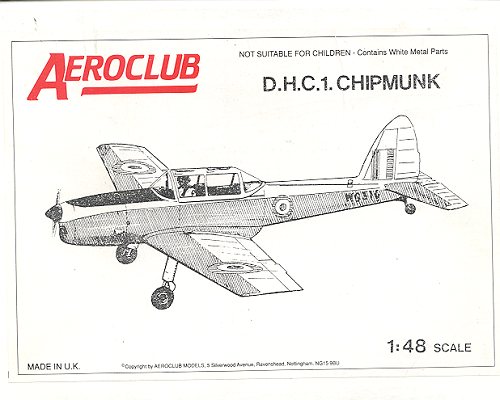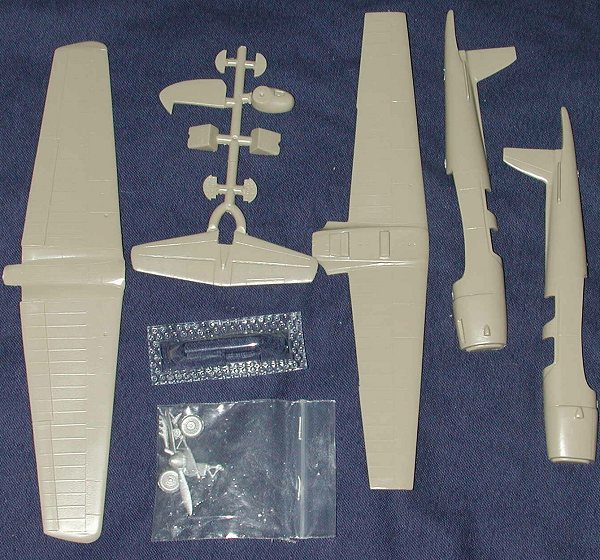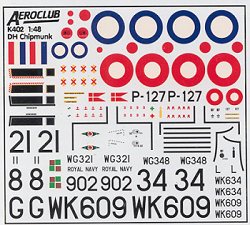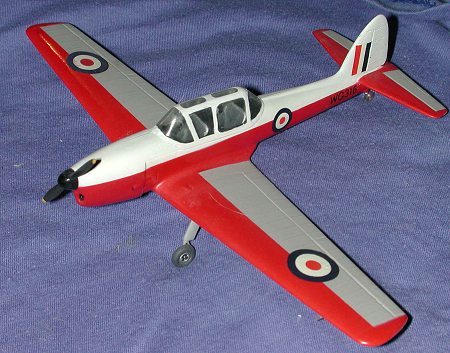
|
KIT: |
Aeroclub 1/48 DHC-1 Chipmunk |
|
KIT # |
? |
|
PRICE: |
$? |
|
DECALS: |
Four/five aircraft |
|
REVIEWER: |
|
|
NOTES: |
Injection molded with metal bits and vac canopy |

|
HISTORY |
The Chipmunk was the first primary trainer manufactured by De Havilland Canada, of Downsview (North York) Ontario, as a successor to the Tiger Moth. The first prototype flew in 1946 and the design proved most successful. Approximately 1000 were built, including some that were made under license in England and Portugal.
The RCAF accepted its first DHC-1 Chipmunks in 1948 and did not retire the last one until 1972, three years after unification in 1968 had led to the demise of the RCAF. The Chipmunk's long service was due, in part, to its fully aerobatic capabilities and superb flying characteristics, similar to the Spitfire's, which made it a delight to fly. It is also a mechanically sound aeroplane and, consequently, many Chipmunks are still operational around the world.
|
THE KIT |

To some, this kit may look quite familiar. I know it does to me because the
Aeroclub DHC-1 was the first full vacuformed kit that I ever built, back in
(cough, cough, hrrump)...... In fact, the canopy and the metal bits are
exactly the same as in that kit. What has changed are that the vac parts have
been replaced by injected pieces. These bits are quite typical of an Aeroclub
injected kit in that they are of a relatively hard tan plastic and rather well
detailed for a short run kit. To say that it is fully detailed wouldn't exactly
be the truth as you are given a basic aircraft that has all the right bits on
the outside, but will need quite a lot of interior additions to be brought up to
Tamiyagawa standards. To whit, there is but a pair of seats, sticks and
instrument panels for a very large interior. The addition of interior framework,
rudder pedals and all the usual throttles and other knobs and switches will need
to be added by the fastidious builder.
The instructions are also very much like on the vac kit, i.e. they are minimal and totally written. However, this is a minimalist kit. What has changed is that there are now five decal options whereas the vac kit only had one. Those options are: WK609 of 3 AEF, WG 321 of Leeds UAS, WG 348 of the Central Flying School, WK 634 of the Naval Flying Graduate School and P-127 of the Royal Danish Air Force. Each of these aircraft carry a different scheme and all will be quite fetching once the kit is completed. The decals are quite well printed and rather glossy to boot. I also would surmise that they are a bit on the transparent side and since several of these schemes have bright red or da-glo colors, covering them up with these decals will be a poser.

For those of you wanting to see what the vacuformed kit looks like completed, here's a shot of WG 316 on the left. One thing I know about this newer injected kit, I won't leave the masking on the window for a year and a half before removing it. Man, what a mess that was!
|
CONCLUSIONS |
You really can't go wrong with this kit. It is quite basic as model kits go and of a subject that has only been done once before, that being the old Airfix 1/72 kit. For the larger scale fans, I can recommend this one to add to your basic trainer collection.
If you would like your product reviewed fairly and quickly by a site that has well over 175,000 visitors a month, please contact me or see other details in the Note to Contributors.